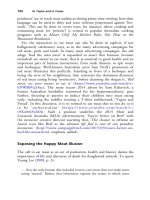The palgrave international handbook of a 220
Bạn đang xem bản rút gọn của tài liệu. Xem và tải ngay bản đầy đủ của tài liệu tại đây (39.26 KB, 1 trang )
Collecting Wildlife
215
Department of Fish and Game or US Fish and Wildlife Service) are all
present. In addition, claims for the legitimacy of oology as valuable scientific
study have been made, by for example the Jourdain Society, an oological
society that promoted the collection of eggs for scientific study (Braid 1994),
highlighting the fact that the study of eggs and eggshell thinning in the 1950s
highlighted the harm being caused to wildlife by pesticides such as DDT.
Egg collecting has been likened to a form of kleptomania where offenders’
compulsive behaviour drives them to commit crimes and experience the
adventure involved in doing so. Rather like a collector of stolen paintings,
some of whom pay large sums of money for stolen works, egg collectors may
in part be driven by the acquisition of an item that cannot be obtained
legitimately. Pleasure is also derived by the act of possession with the acquired
item serving as a reminder of the adventure gained in its acquisition. Some
stolen works of art, many of which are recognisable cannot be traded on the
open market but are acquired for private collectors to appreciate. Burke
(2001) suggested that the trade in ancient manuscripts and historic books
in the UK was worth millions of pounds with criminal gangs turning to
trafficking for private collectors and with thefts of works by Copernicus and
Ptolemy being commissioned by private collectors. Although there is evidence
of some stolen works being traded (Burke 2001), the drive to obtain items
for personal use and which cannot be publicly exhibited is a primary factor of
the obsessive collector. Taylor and Quayle (2003) explain that ‘the emotional
intensity that is part of collecting behaviour’ (2003, p. 48) is a significant
factor with the collector interacting with others who share his interests and
often being driven to have a bigger, better and more comprehensive collection than others. The competitive drive and the obsessive need to acquire
items can turn a hobby interest in certain items into a passionate desire to
collect (Belk 1995; Taylor and Quayle 2003).
The obsessive nature of animal collecting offences is confirmed by egg
collectors themselves. Egg collector Derek Lee confirmed this to The
Guardian stating that many egg collectors are consumed by their habit and
simply cannot stop. He explains that:
There are quite a few who are obsessed with it. Every single spring and summer
they can’t wait to get out. If you put a child in a chocolate factory their eyes
light up with excitement. It’s like that. When spring and summer come, the
eggers are on edge. They’re like big kids. (Barkham 2006)
The obsessive-compulsive nature of offending is a factor, and the meticulous
notes retained by collectors is, in fact, used by investigators as evidence of
their offences (Barkham 2006; Wood 2008). The UK legislation also allows









